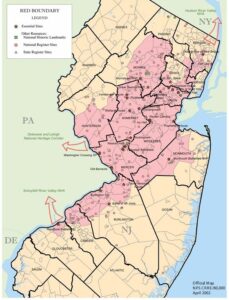“Commemoration is a mirror,” writes historian Seth Bruggeman. “Reflected in portrayals of the past are glimpses of today’s hopes, fears, insecurities, and grudges,” he concludes.1 In many ways, the work of Princeton University undergraduate students in the spring 2024 class, Commemoration, Crisis, and Revolution in the City, has been to hold this mirror up and examine the resulting reflection as the United States prepares for the Semiquincentennial—or 250th anniversary—of the beginning of the American Revolution in 2026. This website, “Commemorating 1776, Past and Present,” is the result of those critical examinations. With backgrounds in public and international affairs, electrical engineering, economics, and chemistry, students have spent the spring semester learning how commemorative practices intersect with social and political movements, urban redevelopment, and American history more broadly.

As the “Crossroads of the Revolution,” New Jersey is perhaps one of the best places to study how Americans have chosen to commemorate the American Revolution. So named in reference to the pivotal role of New Jersey in the events of the Revolution, the “Crossroads of the Revolution” is the official name of New Jersey’s only designated National Heritage Area (NHA) spanning 14 of the Garden State’s counties. First created in 2006, the “Crossroads of the Revolution” NHA is itself a product of ongoing efforts to leverage heritage for economic and urban redevelopment. Managed by a nonprofit organization in partnership with public and private partners, the “Crossroads of the Revolution” NHA continues to connect public audiences with New Jersey’s Revolutionary heritage. As 2026 approaches, New Jersey is well-positioned to play a larger role in the upcoming commemoration.
The work of students in Commemoration, Crisis, and Revolution in the City captures how residents of the Garden State have approached the Revolution from the nineteenth century to the present day. To inform their research, students have visited heritage sites within and beyond New Jersey who are rethinking how Revolutionary-era stories are told as they prepare for 2026. With generous support from the Effron Center for the Study of America and the Program for Community-Engaged Scholarship (ProCES), students have had opportunities to visit with and learn from interpretive and curatorial staff at Morven Museum & Garden in Princeton; Independence Hall National Historical Park in Philadelphia (figure 1); and the Stoutsburg Sourland African American Museum in Skillman, New Jersey. In the classroom, students have learned how the process of commemoration is always one rooted in contemporary politics, and our course visits have excavated how our current social and political climate is informing efforts to commemorate the meaning and legacy of the American Revolution. Efforts to tell underrepresented and marginalized stories such as those of enslaved Africans, women, and grassroots social actors predominate at contemporary heritage sites—a product of the shift towards diversity and inclusion in the field of public history more broadly in the last decade. The work of students in Commemoration, Crisis, and Revolution in the City embraces this trend by capturing little-known stories of Garden State residents who have tapped into heritage and history to make meaning of their present moments. As 2026 fast approaches, this work will hold increasing significance as we hold the mirror of commemoration up to understand our hopes and fears for our nation’s future.

- Seth C. Bruggeman, ed., Commemoration: The American Association for State and Local History Guide (New York, NY: Rowman & Littlefield), 9. ↩
